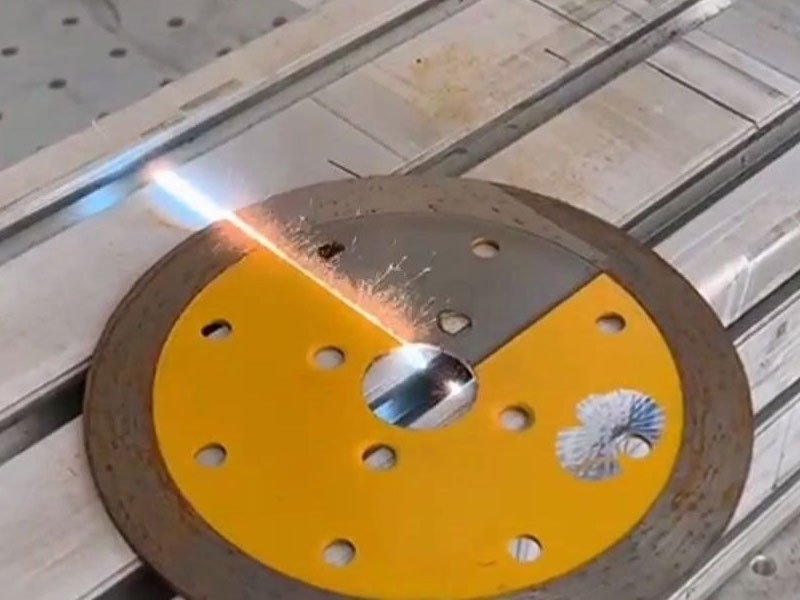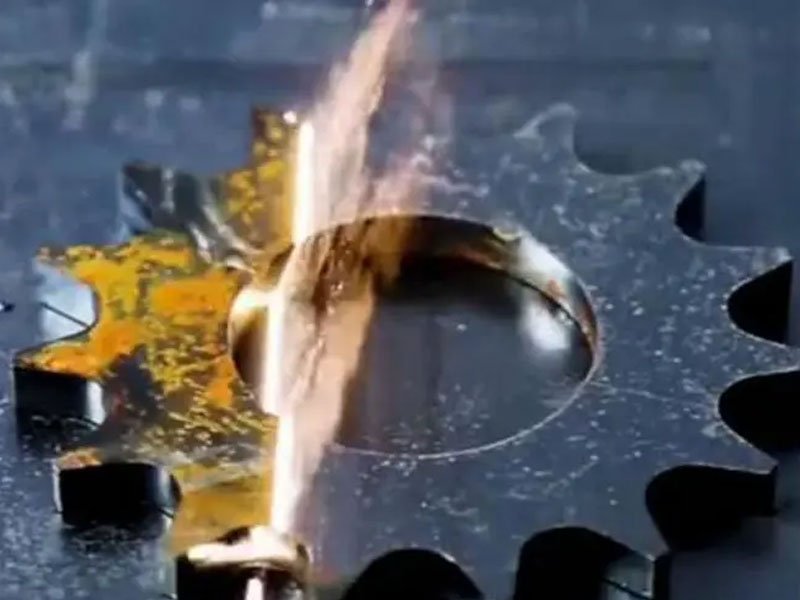Laser light paint remover for metal is a revolutionary technology that utilizes high-powered lasers to effectively remove paint and coatings from metal surfaces. This innovative process offers numerous advantages over traditional methods, providing a precise, efficient, and environmentally friendly solution for paint removal.

Industrial Laser That Removes Paint Solutions
Laser paint strippers utilize a high-powered laser beam to evaporate paint without damaging the underlying metal. The laser’s precisely focused beam enables targeted removal, minimizing the risk of over-etching or surface damage. This makes it ideal for delicate or complex metal parts.
What Is the Process of Laser Light Paint Remover
Laser light paint remover is a revolutionary technology that has transformed the process of removing paint from metal surfaces. Unlike traditional methods that involve harsh chemicals or abrasive blasting, laser light paint removal is a non-contact, environmentally friendly, and highly precise technique.
The process begins with a high-powered laser beam that is directed onto the painted surface. The laser’s energy is absorbed by the paint, causing it to vaporize and break down into smaller molecules. This vaporized paint is then removed by a vacuum system, leaving the metal surface clean and undamaged.
Advantages of laser light paint removal
Precision. The laser beam can be precisely controlled to target specific areas of the surface, allowing for the removal of paint without affecting the underlying metal. This makes it ideal for delicate or intricate surfaces, such as those found in automotive restoration or antique preservation.
Non-contact process, eliminating the risk of surface damage that can occur with abrasive blasting or chemical stripping. The laser beam does not come into direct contact with the metal, ensuring that the surface remains intact.
Environmental friendliness. Unlike chemical paint strippers, which can release harmful fumes and require special disposal, laser light paint removal does not produce any hazardous waste. The vaporized paint is simply removed by the vacuum system, leaving no residue behind.
The process of laser paint removal is relatively simple. The surface is cleaned to remove any dirt or debris. The laser is then positioned and focused on the painted area. The laser beam scans across the surface, vaporizing the paint and removing it via a vacuum system.
Safety.Laser paint removal is safer for operators as it eliminates the need for harmful chemicals and reduces exposure to dust and debris. Advanced laser systems also include safety features like fume extraction and containment.
Consistent Quality.The controlled nature of laser paint removal ensures consistent and repeatable results, which is crucial for applications requiring high-quality finishes.
The speed and efficiency of laser paint removal depends on the type of paint, the thickness of the coating, and the size of the surface. However, it is generally much faster than traditional methods, saving time and labor costs.

How Does Laser for Paint Removal Work?
A high-powered laser beam is directed onto the painted surface. The energy of the laser is absorbed by the paint, causing it to vaporize and decompose. The vaporized paint is then removed by a vacuum system, leaving the underlying metal surface clean and intact.
The key to laser paint removal’s effectiveness is its ability to selectively target the paint without affecting the metal substrate. This is achieved by carefully controlling the wavelength and power of the laser. The wavelength of the laser is chosen to match the paint’s absorption spectrum, ensuring maximum energy absorption. The power is adjusted to vaporize the paint without damaging the metal.
Compared to traditional methods
It is a non-contact process, eliminating the risk of surface damage. Second, it is very precise and can remove paint from specific areas without affecting surrounding surfaces. Third, it is environmentally friendly and does not produce hazardous waste or emissions.
The process is particularly suitable for removing paint from complex geometries, such as complex castings or welded assemblies. It is also ideal for applications where surface integrity is critical, such as in the aerospace or medical industries.
A variety of sizes and configurations are available to meet different needs. Handheld systems are suitable for small-scale applications, while large systems can handle large projects. The choice of system depends on the size, complexity and accessibility of the surface to be painted.
Applications for Laser Paint Remover
- Aerospace Industry:
- Aircraft Maintenance: Laser paint removal is used for stripping paint from aircraft surfaces during maintenance and repainting procedures. This method minimizes the risk of damaging the underlying metal surfaces.
- Component Restoration: Restoring and refurbishing aircraft components, such as engine parts and landing gear, by removing old paint and coatings without causing thermal damage.
- Automotive Industry:
- Car Body Repair: Efficiently removing paint from car bodies during repair and restoration work, ensuring a clean surface for repainting or other treatments.
- Component Cleaning: Cleaning paint and coatings from automotive components, such as engine parts and frames, to prepare them for inspection, maintenance, or re-coating.
- Marine Industry:
- Ship Maintenance: Removing paint and coatings from ship hulls, decks, and other components during maintenance and refurbishment, helping to prevent corrosion and ensure smooth surfaces.
- Marine Equipment: Cleaning and stripping paint from marine equipment, such as propellers and anchors, for maintenance and performance enhancement.
- Construction and Restoration:
- Building Restoration: Stripping paint from historic buildings and monuments without damaging the underlying materials, preserving architectural integrity.
- Surface Preparation: Preparing construction surfaces, such as steel beams and concrete walls, for new coatings or treatments by removing old paint and coatings.
- Manufacturing Industry:
- Production Line Cleaning: Removing paint and coatings from production line equipment and tooling to maintain efficiency and prevent contamination.
- Quality Control: Ensuring the quality of manufactured products by stripping paint from defective items for rework or inspection.
- Electronics and Precision Engineering:
- PCB Cleaning: Removing unwanted coatings and residues from printed circuit boards (PCBs) and other electronic components without causing damage.
- Precision Parts: Stripping paint and coatings from precision-engineered parts and components used in various high-tech applications.
- Military and Defense:
- Weaponry and Equipment Maintenance: Cleaning and refurbishing military vehicles, weapons, and equipment by removing paint and coatings to ensure optimal performance and longevity.
- Aircraft and Naval Vessels: Stripping paint from military aircraft and naval vessels for maintenance and repainting, ensuring readiness and reliability.

Why Choose Laser That Removes Paint?
- Superior Precision:
- Lasers provide unmatched precision, allowing for targeted removal without affecting surrounding areas. This is essential for applications requiring high accuracy.
- Environmental Responsibility:
- Choosing laser paint removal aligns with environmental sustainability goals. The method is clean and eco-friendly, minimizing environmental impact.
- Long-Term Cost Savings:
- Although the initial investment in laser equipment may be higher, the long-term savings on materials, waste disposal, and labor make it cost-effective.
- Versatile Applications:
- Lasers can handle various surfaces and paint types, making them suitable for diverse industries and applications.
- Improved Workplace Safety:
- By reducing the need for harmful chemicals and minimizing dust and debris, laser paint removal creates a safer working environment.
Is Laser Light Paint Remover on Wood
Laser paint removal can be used on wood, but with certain considerations:
- Controlled Settings:
- The laser settings need to be carefully controlled to prevent burning or damaging the wood. Lower power settings and precise control are necessary.
- Surface Preparation:
- Laser removal is excellent for preparing wooden surfaces for repainting or refinishing. It can strip paint without harsh chemicals, preserving the wood’s integrity.
- Historical Restoration:
- For restoring historical wooden artifacts or structures, laser paint removal provides a gentle and non-invasive method, preserving the original wood.
- Selective Removal:
- The ability to precisely control the laser allows for selective paint removal, which is useful in restoration projects where only certain layers of paint need to be removed.

FAQ
How Long does it Take to paint removing laser?
The time varies based on the coating thickness and area size but is generally much faster than traditional methods. It can range from a few seconds to several minutes per square foot.
Can Lasers Remove Epoxy, Urethane or Other Tough Coatings?
Yes, lasers can effectively remove tough coatings like epoxy, urethane, and other durable materials.
Will Lasers Damage Underlying Surfaces like Wood or Fiberglass?
Lasers can be adjusted to avoid damaging underlying surfaces, but careful control and skilled operation are required, especially for sensitive materials like wood and fiberglass.
How Big of an Area can Industrial Laser Systems Treat?
Industrial laser systems can treat large areas, with some capable of covering several square meters per hour, depending on the power and settings.
Can Touch-ups be Done after Laser Stripping?
Yes, touch-ups can be easily done after laser stripping to ensure all areas are clean and properly prepared for repainting or other treatments.
What Certification or Training is Required to Operate Industrial Lasers?
Operators typically need specific training and certification, which may include safety protocols, equipment handling, and laser operation procedures. This training is often provided by the laser equipment manufacturer or specialized training institutions.
